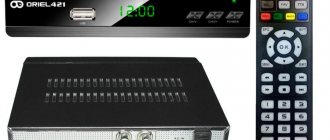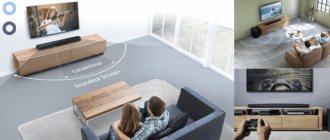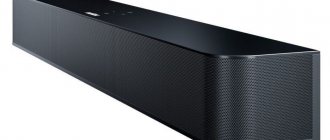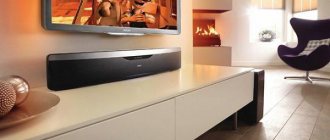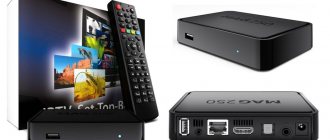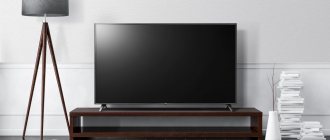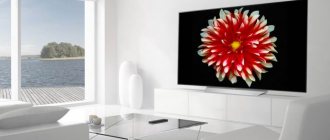A soundbar is a compact but very powerful audio system for the home , which is suitable for watching movies in maximum sound realism, for playing video games, and for listening to music.
The main advantage of a soundbar over other types of acoustics is its miniature size and light weight , which allows it to be placed even in a small room, even on the wall.
Soundbars are produced by many companies, including the reliable brand LG. The article will discuss the features of LG audio systems and some popular models.
Page navigation:
LG SL10Y
The soundbar integrates perfectly with LG TVs and reproduces not just high-quality, but deep and surround sound. The model has a discreet and stylish design, so it will not stand out much in the interior.
Main characteristics of the model
- standard: 5.1;
- dimensions of the main module (WxHxD): 1443x63x146 mm;
- subwoofer dimensions (WxHxD): 221x390x313 mm;
- main module weight: 7.5 kg;
- subwoofer weight: 7.8 kg;
- total power: 570 W;
- number of columns: 1 pc.
Advantages
- + high-quality sound regardless of the selected volume level;
- + no noise or other interference;
- + films have a gorgeous soundtrack, which creates the effect of complete immersion;
- + if you reduce the volume, the special effects are saved;
- + if the content is of high quality, it can be used as a music center;
- + sufficient volume reserve for an apartment;
- + it is possible to simultaneously use the soundbar with other devices;
- + easy to control the device;
- + easy connection;
- + can be hung on the wall.
Flaws
- — when playing MP3 files, the sound is flat, as if “from a barrel”;
- — very large sizes, the kit does not include the necessary wires;
- — dust quickly accumulates on the surface;
- - There are different languages, but there is no Russian.
Best deals
9.
Speaker system for LG SJ8 TV
Soundbar with wired and wireless connection to signal sources
The relatively recently introduced family of sound bars is gaining increasing popularity - at least judging by the number of offers of different models from different manufacturers.
When we reviewed the Philips model two years ago, we described in detail the features and capabilities of this class of devices, so now we will limit ourselves to just a brief listing of them.
A soundbar is a multi-channel speaker system, the main device of which is made in the form of a monoblock, whose shape should be as compatible as possible with modern flat-panel TVs, and therefore is a very horizontally elongated module with very little depth and especially height.
Such a geometry does not allow placing any large-sized woofers, and even creating the volume necessary for high-quality reproduction of the lower frequencies of the audio range, so most often they use a separate subwoofer.
Inexpensive samples have 2.1-channel sound, more advanced ones have 4 or 5 channels (in addition to low-frequency), you can find 7.1- and even 8.1-channel models.
However, the speakers of all these channels are located in front of the listener at a limited distance, and therefore cannot naturally recreate the surround sound picture, and you have to resort to its virtualization using digital signal processing algorithms, which differ from one soundbar manufacturer to another.
However, the monoblock design also has a significant advantage: there is no need for a large number of cables, especially considering that the subwoofer is also connected wirelessly. Of course, you can’t do without wires completely - you need to connect to power (AC mains), and often to signal sources, but if you compare it with “classic” sets with the same number of channels, then there are much fewer cables.
In the line of soundbars officially offered today by LG to Russian consumers, there are two series - the earlier SH, as well as SJ, all models of which are marked as new on the official website. The youngest of them is SJ2, which provides 2.1-channel sound with a total power of 160 W (RMS). In the older SJ9, the channel formula looks like 5.1.2 - the main device, in addition to those located frontally, also contains two upward-facing speakers, and the total power reaches 500 W.
For all representatives of the series, the possibility of remote control is declared not only from the included remote control, but also from the TV remote control, not only from LG, but also from many other leading manufacturers: Sony, Philips, Sharp, Panasonic, Vizio, Toshiba and Samsung. And this is a very useful feature: the number of remote controls in some home audio-video systems sometimes exceeds reasonable limits. Of course, the TV remote will not be able to provide full control of the soundbar, as the instructions honestly say, but even combining only the main function - volume control - in one remote control will be useful.
We received the LG SJ8 , which claims 4.1-channel sound.
Main parameters, equipment
The specification given in the Russian-language section of the official website does not always accurately and unambiguously define the device parameters. If some points like the mixed up sizes of the soundbar and the main device or some inconsistency in terminology (the main device can be called both the main module and the soundbar) can be attributed to trifles, then others can cause confusion.
Thus, with the declared 4.1 sound formula, implying five channels of sound reproduction, the output power is indicated as “65 W × 2” and 170 W for the subwoofer, for a total of 300 W. But what is more alarming is that two times 65 watts are for the front speakers, and there is a dash in the line “Surround sound speaker”. Let's try to figure this out when analyzing the design.
Energy consumption is also indicated somewhat strangely: figures are given for standby mode (they do not raise questions) and simply “power consumption” - 22 W for the main device and 33 W for the subwoofer, which is clearly not enough for playback at a more or less significant volume, but a bit too much for the state with no signal at the inputs.
Therefore, in the table, all data that we could not confirm with our own measurements is presented in accordance with what is available on the website or in the instructions in Russian.
| Specifications LG SJ8 | |
| Subwoofer | |
| Dimensions (H×W×D), mm: | 320×171×252 |
| Weight , kg | 4,3 |
| Woofer: | |
| diffuser diameter | 14 cm |
| acoustic design | bass reflex, front speaker, rear port |
| body material | MDF |
| Main device | |
| Audio DAC | 192 kHz / 24 bit |
| Dimensions (H×W×D), mm: | 38×1220×105 |
| Housing material | plastic |
| Weight (without external power supply), kg | 2,7 |
| Front sound channel speakers: | |
| diffuser shape | oval |
| diffuser size , cm | 7,5×2,9 |
| quantity per channel | 2 pcs. |
| Tweeters: | |
| diffuser diameter , cm | 2,0 |
| diffuser material | polymer |
| quantity per channel | 1 PC. |
| Output power, W (declared, RMS) | |
| general | 300 |
| subwoofer | 170 |
| main device | 2 × 65 |
| Energy consumption, W | |
| Standby mode | 0,5 |
| soundbar/subwoofer | 22 / 33 |
| Remote control | yes, wireless |
| Package size, mm: | 1276×373×223 |
| Link to description | lg.com/ru |
| average price | find out the price |
| Retail offers | find out the price |
| — measured in our laboratory. | |
We received a "press copy" - without the shipping box and all accessories. Therefore, we present the equipment according to information received from the official website:
- user guide,
- PC software,
- remote control with batteries,
- optical cable,
- wall mounting kit,
- warranty card.
A kit for wall mounting the main device will allow you to avoid any bedside tables or stands; it includes a pair of brackets and a template for marking, and you will have to select dowels and screws yourself in accordance with the characteristics of the wall material. The main module not only lies on the horizontal planes of the brackets, but is also attached to them with screws that are included in the kit.
The instructions also mention additional legs with a height of 16.5 mm, with the help of which you can change the placement height if you still use a stand. They are not mentioned on the site, but in the picture in the quick guide showing the contents of the kit, there are such legs and several disposable cable ties.
Stated capabilities
Let us briefly reproduce and comment on what is stated by the manufacturer.
- The design of the soundbar matches the TV perfectly. Naturally, we are talking about LG TVs, and not even all, but certain models - there is even a special stand for them, the front protrusions of which fit into grooves on the back wall of the SJ8, which will allow you to seamlessly connect two devices when installed on the same plane. But, of course, it will be a good combination with any other flat-panel TV, and it is desirable that its diagonal be 55 inches or more.
- The ultra-thin design does not distort sound or interfere with viewing or audio control. Let us remind you: the height of the main device is 38 mm, and this is really not much - among models from LG and other brands it is very difficult to find an analogue with a smaller height. We have no particular doubts about the absence of interference with viewing and control, but with regard to the quality of sound reproduction, size most often matters if we are talking not only about the upper frequencies of the audio range.
- Allows you to play digital files in high quality formats such as FLAC, WAV and ALAC. The list of supported formats and audio signal processing methods is wider, it includes LPCM, Dolby Digital, DTS Digital Surround, OGG (up to 48 kHz), FLAC (up to 192 kHz), WAV, ALAC, MP3, WMA, MPEG2 AAC, AAC+, AIFF.
- The soundbar allows you to play 4K sound and broadcast 4K images to your TV without losing quality. If “4K” in relation to video is not just a generally accepted concept corresponding to an image with approximately 4 thousand elements (dots) horizontally, but also a marketing term approved by the Consumer Electronics Association (CEA), then “4K audio” should be attributed more to the manufacturer's own terminology, in this case LG. The 4K sound announced for the SJ8 and a number of other soundbars from this company does not directly refer to the soundtrack of films in Ultra HD format and means something completely different - the ability to play audio with a bitrate of 4000 kbps (24 bit × 96 kHz × 2 channels). As for broadcasting the image to the TV, this is a completely normal pass-through function, in which the signal source is connected with an HDMI cable to the input connector of the soundbar, the output connector of which is connected to the TV with a second cable of the same type. Often, signal transmission is ensured even when the soundbar is in standby mode.
- Adaptive Sound Control ASC is LG's proprietary voice enhancement technology: real-time voice level analysis with automatic bass reduction to enhance voice clarity (e.g. in dialogue/news programs). It is very difficult to give an objective assessment of the effectiveness of such technologies, usually their effect strongly depends on the specific content - in some scenes the voice will actually sound clearer, in others it is difficult to feel the difference, in others speech intelligibility may even deteriorate, but in such a case this function can be disabled.
- LG Auto Sound Engine (ASE) technology optimizes the balance of sound frequencies to avoid distortion even at maximum volume levels. Based on the illustrations given in official materials, it is difficult to judge what lies at the heart of ASE: the graphs demonstrating the optimization process have a frequency along the vertical axis, but it is not clear at all what is happening along the horizontal axis. But this is normal: manufacturers never specify in detail the work of their own know-how, preferring to use general phrases.
- The soundbar can play audio from mobile devices or apps via Wi-Fi or Bluetooth. Naturally, we will try this.
- Wide range of connectivity options. To be precise, they are really wide, but not the widest: for example, there are no analogue audio inputs, microphone inputs for karaoke lovers, there is also no FM tuner - we are only listing what is present in other current LG soundbars today (albeit, a full set not in any of them).
- Broadcasting from YouTube, Google Play and other services using Google Cast is supported.
Appearance, design
Main device
This is a very horizontally elongated module with a very small height. The depth is three times the height, so the block appears long and flat.
The module is powered by an external power supply included as standard, which can operate from AC mains with a voltage of 100–240 V and a frequency of 50/60 Hz. Output: 25V, 1.52A (38W max).
The front surface, onto which the speakers extend, is covered with a decorative metal mesh, which also extends onto the sides of the case.
Through the holes of this grille in the center you can see an alphanumeric indicator on lunar-white LEDs, below it is another LED that displays the operating mode (white - the soundbar is on, red - off).
The alphanumeric indicator is somewhat recessed, so viewing angles are limited: horizontally about 120° (or ±60° from normal), vertically about the same. But even to an observer sitting opposite the soundbar, the displayed letters and numbers will not be visible very well - the grille is in the way. It also hides the brightness, but this is rather a plus: even in a darkened room, the symbols do not seem overly bright, and in addition, if there is no manipulation of the remote control or buttons for about 30 seconds, the indicator dims a little. If there is no activity, including signals at the inputs, for a long time, the soundbar turns off (the LED turns red), but this function can be disabled.
Both the base with numerous round legs made of thin rubber and the cover covering the top and back of the module are made of plastic, so with such a significant length the structure is not very strong and rigid, and the instructions require that you avoid any impact (of course, physical, associated with significant effort) on the device.
The rear side has interface connectors: optical and two HDMI (input and output), for a wired local network and an external power supply. There is also a USB type A port, which is intended for service purposes, and not at all for removable drives.
In passing, we note: if the soundbar is turned off (the mode LED lights up red), end-to-end signal transmission from the HDMI input to the HDMI output is not carried out in this model.
On the right there are six buttons for controlling some functions without using the remote control. Moreover, the buttons themselves are on the back side; only the symbols indicating the purpose of each of them are placed on the top surface.
It is difficult to say how convenient it will be to use such a control panel, especially if mounted to a wall; We can only share our own impressions received during our “communication” with the soundbar: although the main device stood freely on a standard office desk most of the time, we didn’t really like working with the buttons, so we mostly used the remote control. We did not receive the brackets, and we cannot assess whether, when mounted to the wall, there will be a gap for access to the control panel. However, duplication of control of some functions, allowing you to do without a remote control, is only welcome.
All connectors are also directed backwards, but are located in niches, so the connected cables should not interfere with the wall placement of the device. The instructions only recommend making all the connections before installing them on the brackets, since this will not be easy to do later.
However, we used high-quality, thick, braided, and therefore quite rigid HDMI cables. It is simply impossible to bend such a cable 90° with a minimum bending radius; at least 5-6 centimeters will be required behind the back wall, so before installing the brackets for the main soundbar device, check how things are going with your existing cables.
The upper and lower parts of the case are connected by an incredible number of screws, but we still removed them and disassembled the module: we really wanted to check which scheme the soundbar configuration corresponds to - 4.1, as indicated in the list of main characteristics, or 2.1, as follows from the lines specifications regarding power output.
So, pay attention: there are still four channels (not counting the low-frequency). They are implemented on a pair of TI TPA3118 microcircuits - two-channel class D power amplifiers. With the declared output powers, limited by the capabilities of the external power supply, the heating of such amplifiers, taking into account their high efficiency, will be insignificant, so there are no radiators; the board itself is used to remove heat, it is used for The amplifier is separate, and the power connector is wired on it. However, if you use the top cover for a long time in the area where the amplifiers are located, you may feel some heat.
In each of the microcircuits, one channel is loaded onto two parallel-connected mid-range speakers, and the second onto one high-frequency head. That is, the declared four channels are implemented as two stereo channels with bi-amping in each.
Thus, all the definitions given in the description - both the “4.1” formula and the seemingly contradictory dash for surround sound speakers - turn out to be correct. But when you see the phrase “4.1 channel sound,” you still expect something slightly different.
But there is no point in worrying about this: we have already said that in soundbars, the front and surround speakers are still placed side by side, and to achieve a spatial effect, manufacturers have to use software tricks that cannot fully replace four physically separated speakers.
Let's return to the design. The tweeters in the main device are quite ordinary - dome with a polymer emitter with a diameter of 20 mm.
But the midrange speakers have an original design developed by LG: the driver is made in the form of a flat plate made of thick paper on a rubber suspension with dimensions of 75x19 mm. Speakers of this shape are often called oval, although in this case it is not the classic oval from the geometry course, but rather two semicircles connected by straight lines. The manufacturer claims that this design can provide sound quality no worse than large speakers.
Groups of three speakers (2×MF and 1×HF) are spaced to the very edges of the body and separated from the rest of the volume by plastic casings equipped with seals at the joints and a lining made of a thin rubber sheet.
Now about the other elements used to process the signal and control the soundbar. The most noticeable and largest of them is Silicon Image Sil977CLUC, a processor for servicing HDMI ports. There is also an ADAU1452 digital audio processor, a TI M430F5438 microcontroller and two Nanya NT5CB64M16GP memory chips. All of them are located on the largest board, on which all interface connectors are soldered. Both boards, amplification and signal processing, are connected by a double-row multi-pin connector.
There are also separate small modules - with display elements and buttons (they are clearly visible), as well as others, probably intended for communication: LAN, Wi-Fi, Bluetooth, but to access them you would have to disassemble too much, and there is no work to do We did not make such significant clarifications.
Subwoofer
The acoustic design of the subwoofer is a bass reflex, the speaker is located in the front and is covered with a non-removable decorative panel in the form of a metal grille on a plastic frame. Under this panel there is a full MDF front wall with a hole for the speaker.
The bass reflex port is located at the rear (remember: such a subwoofer cannot be placed close to the wall). The back wall is also plastic, but it has additional internal support in the form of an MDF panel with large slots. Let us note in passing: they also did not spare the screws for attaching the rear wall.
The junction of the edges of the rear wall with this support is equipped with seals; there are no sound-absorbing materials in the internal volume, only the wires located there are placed in foam sleeves.
The body is equipped with legs in the form of round rubber stickers with a diameter of 2 cm and a free thickness of 2 mm.
The MDF from which the subwoofer box is made is clearly not of the highest grade, which is clearly visible in the sections: the structure of the material is loose. However, the thickness is quite decent - 12 mm, and only the rear additional support is slightly thinner.
A speaker with a coil resistance of 3 ohms has a cone diameter of 14 cm (over the suspension).
The electronic filling is fixed on the inside of the back wall. The common board contains a switching power supply and a power amplifier; there is a separate Bluetooth module connected to the main board with a flexible cable.
It should be noted that the input circuits of the power supply are equipped with a full-fledged LC filter and varistor protection; the fuse in our sample was generously smeared with a fixing compound, and we could only see that it was sealed into the board.
The power amplifier is based on the TI TAS5612LA microcircuit - a class D amplifier, the four channels of which in this case are connected according to the PBTL circuit (Parallel Bridge-Tied Load, parallel-bridge mode). According to the datasheet, in this case the amplifier into a 3 ohm load can actually deliver the power indicated in the specification.
To normalize the thermal regime, the microcircuit is equipped with a small (but not tiny, as is sometimes the case) aluminum plate heatsink. There are no ventilation holes in the subwoofer housing other than the bass reflex pipe: the efficiency of class D amplifiers is quite high. And indeed: even during prolonged operation, heating of the rear wall is not observed.
The signal received from the Bluetooth module is first processed by the Pulsus PS9860 digital audio processor, after which it is fed to the inputs of the power amplifier.
On the back wall of the speaker, in addition to the bass reflex port, there is only a connector for the power cable and a button for initializing pairing with the main device via a wireless channel (we didn’t have to use this button: the devices always “paired” automatically after switching on). There is also a single indicator, the color and lighting mode of which indicate the status: red - the wireless connection is not established, green flashing - the connection is being established, green constant - ready for work.
Naturally, the main module must be placed under the TV, and so that their centers are on the same vertical (there is even a corresponding mark on the template for wall mounting), and the subwoofer can be installed in any convenient place in the room, it is only advisable to have a power outlet at a distance, not exceeding the length of the standard cord - ours was almost one and a half meters long.
Remote control
We said above that we received the soundbar in the form of a test sample. Unfortunately, the remote control was also not final: the significant difference in the purpose of the buttons between it and the one described in the Russian-language instructions we downloaded is not so bad, the differences are not so great, and the functions of the buttons are not so unusual that some actions cannot be guessed.
What’s worse is that only the Power, Mute, input selection and volume control buttons actually worked (we’ll tell you below that under certain conditions, track playback control also worked). And the control panel on the main device does not fully replace the remote control, so we were not able to try a number of possible settings.
But we can say that the settings made (at least the volume level and the selected input) are saved even after the power is completely turned off.
We were assured that the “native” remote control that comes with commercial samples is exactly the same in design, etc., only the purpose of the other buttons corresponds to the functions of controlling the SJ8 modes. Therefore, we will only evaluate the convenience of working with the remote control, but will not describe it in detail.
The sensitivity of the IR remote control sensor is quite decent: with fresh batteries, it works in almost any position of the remote control relative to the main device, including a reflected signal.
The remote is small, but not tiny; Due to the fact that its back side is made in the shape of a “boat”, it fits snugly in the hand. The buttons are comfortable, the pressing force is quite comfortable - moderately soft, but with clear operation. But they are all the same size, and without significant gaps between functional groups, so using them blindly will require some getting used to.
For lovers of precision, let us inform you: the dimensions of the remote control are 110 × 45 × 19 mm, it is powered by two AAA alkaline batteries.
Using the soundbar to play music
Music Flow Player (Android)
Of course, the same application is also available for iOS, but due to the lack of free gadgets from Apple, we will consider the version for Android.
The application is freely downloadable from Google Play Market and installed on a smartphone or tablet. To simplify your search, you can simply scan the QR code included in the instructions.
After installation, you need to connect the soundbar. The easiest way that does not require additional equipment is to use Bluetooth. Click on “Product Connection” and you will be prompted to make a simple connection via Bluetooth. There is a warning about the need to turn on the soundbar, then it is searched for and... a product selection window opens, followed by a requirement to connect it via a wired or wireless network.
To still start communicating with the soundbar, you need to go to the Bluetooth settings window of your Android device, search and transfer the found LG SJ8 to the connected/paired category. The soundbar switches to the “BT” (Bluetooth) input, you can already listen to music, but the pass-through for HDMI is disabled. Any adjustments other than volume cannot be made from the application; the playback control buttons (start-pause, track transitions) on the remote control also do not function.
Now we try to connect via the network: the smartphone, of course, via Wi-Fi, and the soundbar, first, to the wired segment of the same router.
To connect the SJ8 to Ethernet, DHCP is required (manual setting of parameters is not provided), and then the process after connecting the cable occurs completely automatically and very quickly, without requiring any additional actions; upon completion, the inscription “Connected” appears for a short time. Only there is no separate designation on the front display for such a connection - “Wi-Fi” is displayed. HDMI passthrough is also disabled.
Before listening to music, you also need to determine the playback device by going through the steps of selecting a category and connection method. For some reason, you are also asked to find a way to connect the soundbar to the TV, but you can skip this step.
The settings of the connected device provide for the definition of a surround sound channel, which, as we found out, the SJ8 does not have, but in the application it is possible to use additional speakers (more precisely, playback devices) in this capacity with a connection via the network. You can connect a number of network devices to listen to music on all of them simultaneously. When manipulating the settings, a request to update the software (firmware) may periodically arise, but we refused this.
At the same time, the functionality of the application is expanded: from an Android device, in addition to adjusting the volume, you can now select sound effects from among the available ones and switch inputs; It is theoretically possible to adjust the stereo balance, but this is not provided for the SJ8.
The playback control buttons on the remote control also begin to work, and during playback the time from the beginning of the fragment is displayed on the front indicator.
It becomes possible to control other soundbar settings (in terms of Music Flow - dynamics). So, it is possible to adjust the subwoofer volume, turn on night mode and automatic volume control. You can even turn off the LED indicator, in relation to the SJ8 this only applies to the mode LED, but not to the front alphanumeric display.
It is possible to rename the device (by default the name “SoundBar 1” is assigned), as well as view some of its parameters - the assigned IP address and system version.
Now wireless connection. DHCP is also necessary for it, but you will need to perform several simple additional operations, including using a smartphone or tablet (in particular, to enter a password, if one is provided when connecting to the network; naturally, its SSID should not be hidden). All actions are described in the instructions.
There will be no differences in operation compared to Ethernet, but the instructions honestly warn about possible problems with the wireless connection - for example, if there is any interference or significant traffic on your Wi-Fi network, playback may not work correctly. And when using additional speakers (for example, to generate surround sound), it is recommended to connect the main one, that is, in this case, SJ8, to a wired segment.
Music Flow for Windows
This application is necessary for listening to music available on your PC, which in this case will play the role of a network media server. Windows operating systems from XP SP2 to "ten" are supported. During installation, you will need to define a shared folder to store music files.
Next comes the installation stage of Music Flow - that’s what it’s called in Russian translation, but the program itself is already installed, and these are just preparatory steps: connecting the equipment. You can skip this step, but we will still comment on it.
When connecting, it is recommended to click the add device button on the SJ8 control panel (we already had it connected to the Ethernet segment).
Unlike what is written in the screenshot, the red light on the soundbar did not blink, but the inscription “Home Cinema Ready” appeared in a creeping line. And the connection process took about two minutes on the computer.
But not a single device was found... Although the multimedia device “Music Flow SJ8” was present in the network environment.
We repeated the search with different states of SJ8 (switched the input to Wi-Fi, tried not to press the add button on the panel), but with the same result.
Having canceled the connection step, we found our soundbar in the program window that opened with the same name “SoundBar 1” as on the Android device.
And the functionality is the same: you can select an input, group devices (if there are several of them), control sound effects, etc.
And the music server became available from our Android smartphone: we were able to remotely launch media files located in the shared folder.
Sound
The sound of the LG SJ8 can be called quite typical for such devices: it is quite comparable to “regular” models of decorative acoustics, and among the worthy ones, and much better compared to speakers built into TVs, primarily in terms of the quality of reproduction of the highest and lowest frequencies.
However, there are also disadvantages typical of soundbars with their specific geometry of the main device and the associated features of the midrange speakers, which, even taking into account all possible technological sophistications, can hardly be called full-fledged.
In principle, the same applies to dynamic heads installed in TVs, but sound bars also have a bass speaker and tweeters, and therefore problems may arise in matching frequency ranges. This is exactly what is observed in the LG SJ8: there are some dips in the sound, precisely due to incomplete coordination.
The dimensions of the subwoofer are also not the most heroic, so you can’t expect it to fully reproduce the lowest frequencies of the audio range. In addition, the spectrum of frequencies reproduced by it extends into the midrange region, so the location of the subwoofer is localized when listening, and it is better to select a place for its installation.
The various presets that we selected in the Music Flow application, and if you have a “native” remote control, you can set using it, change not only the equalization, but, it seems, also the phase, changing the perception of the stereo image. Of course, when choosing, you need to focus not on the name of the preset, but on the subjective perception of the sound picture.
Now measurements.
Frequency response graph of LG SJ8 at default settings
Comparison of equalizer modes - “Standard” and “Cinema” (Music Flow, other default settings)
Frequency response graph of LG SJ8, “Cinema” mode, three levels of subwoofer volume from Music Flow: minimum (−15), average (0), maximum (+6)
Noise and background levels in the absence of a signal are extremely low at any volume setting. Turning it on and off (both with a button from the remote control or control panel, or when manipulating the power supply) can be accompanied by clicks, but not always and with such a low volume that they are often masked by background noise even in a fairly quiet room. There are no noticeable parasitic sounds during adjustments and switching.
The sound has a directionality: when the listener's head deviates from the center of the main block, both horizontally and vertically, the timbre of the sound changes. On some compositions it is noticeably stronger, on others weaker.
Results
Like most soundbars, the LG SJ8 needs to be considered from the right perspective: it cannot become a replacement for a full-fledged home theater, but it will be an excellent alternative to the speakers built into the TV, and the minimum number of connecting cables makes its installation hassle-free.
One of the compelling arguments in favor of the SJ8 when choosing may be its small height, which, given the usual location for such devices below the TV, makes this model unnoticeable - soundbars are still auxiliary devices, and not interior decorations. However, it looks quite stylish, especially in combination with a 55-inch TV.
But “assistance” in dubbing TV programs and videos is not the only function of the LG SJ8 soundbar. It can also be used to play music from desktop computers and mobile devices, and there are a variety of connection options: wired and wireless networks, as well as Bluetooth.
The choice of sources connected by wire is less wide: we can only talk about a digital signal, there are no analogue inputs. However, today this can hardly be considered a minus: it is quite difficult to find a modern device equipped only with an analog output for sound.
LG SJ8 soundbar provided for testing by the manufacturer
LG SL8Y
This compact device allows you to recreate the sound of a movie theater at home. This is made possible by supporting Dolby Atmos and DTS:X technology. The soundbar reproduces digital music of the highest quality. There is support for 4K HDR content.
Main characteristics of the model
- standard: 3.1;
- dimensions of the main module (WxHxD): 1060x57x119 mm;
- subwoofer dimensions (WxHxD): 221x390x313 mm;
- main module weight: 4.4 kg;
- subwoofer weight: 7.8 kg;
- total power: 440 W;
- number of columns: 1 pc.
Advantages
- + stylish appearance;
- + can be connected via optical cable, HDMI or Bluetooth;
- + easy controls;
- + there is an application that can be installed on your phone and control the soundbar via your smartphone;
- + simple and clear connection;
- + watching Netflix series is now a pleasure;
- + you can listen to music from your phone;
- + passing games has reached a completely new level;
- + you can use the TV remote control to control the soundbar;
- + Compatible with Google Assistant.
Flaws
- — the body is very long;
- — to connect Bluetooth, you need to additionally install the Google Home program;
- - high price.
Best deals
8.
Party mood
The immodest dimensions of the mini-systems allowed LG developers to equip them with large and even quite high-quality speakers that are ready to give full sound to the parties. Despite the fact that the speakers, of course, belong to the party segment, Pink Floyd also sounds perky on them, especially Gilmour’s sonorous notes.
The relatively portable mini-system LG X-Boom FH6 managed to accommodate as many as two eight-inch woofers
LG managed to create mini-systems that, by their very appearance, even when turned off, set the mood for a club, party mood, and due to their considerable size, high-quality speakers and funny DJ effects, they sound to match this mood. The festive mood is also added by interestingly implemented light music, completely multi-colored, but harmonious in FH6 and fully emulating parties in OM7560.
The editors remind you that by law it is forbidden to make noise after 11 pm in apartment buildings, but on New Year’s Day, and even with such speakers, we think it is still possible.
Official website: LG FH6, LG OM6560, LG OM7560, LG OM7550K
Prices:
LG FH6 — 18,990 rubles*,
LG OM6560 — 15,990 rubles*,
LG OM7560 — 22,990 rubles*,
LG OM7550K — 21,990 rubles*
*average price indicated
LG SL9Y
This model has a fairly high cost and excellent technical characteristics. The soundbar has a stylish design; it can be placed either on a shelf next to the TV or hung on the wall, making it an interesting addition to the interior.
Main characteristics of the model
- standard: 4.1;
- dimensions of the main module (WxHxD): 1220x54x145 mm;
- subwoofer dimensions (WxHxD): 221x390x313 mm;
- main module weight: 6.3 kg;
- subwoofer weight: 7.8 kg;
- total power: 500 W;
- number of columns: 1 pc.
Advantages
- + excellent sound, pleasant bass;
- + even at maximum volume there is no noise, creaking or other interference;
- + there are both presets and the ability to make independent settings, taking into account your own taste preferences;
- + even tracks from your phone are played in high quality;
- + when watching movies, the sound is like in a movie theater;
- + there is a Bass Blast bass boost mode;
- + perfectly reproduces any frequencies;
- + has a built-in Chromecast player;
- + supports MERIDIAN technology;
- + there is an optical cable for connecting to TV.
Flaws
- - quite high price;
- - the surface is easily soiled, dust quickly accumulates.
Best deals
7.
Comparison of characteristics
When choosing a soundbar, it's best to consider some personal factors and preferences. For the most part, this includes your input options as well as the placement of your soundbar.
Input options
You need to consider the type of inputs and ports your devices have. This includes both the original media device and the soundbar. Some devices may not have an HDMI port. Others may only accept HDMI cables. If your device doesn't allow you to use an HDMI cable, you'll need to make sure you have the proper video cables needed to transfer images between your TV and devices.
This may seem like an obvious specification, but you'd be surprised how many times people make a purchase expecting a certain type of connection, only to find out that their device doesn't actually allow for that cable.
Bottom line: Most Blu-rays, game consoles, and similar devices accept HDMI cables. However, digital optical cables can provide just as good sound if your device doesn't support HDMI. Additionally, if you only want to relay audio, a digital optical cable can provide just that, without the need to transmit video signals between devices.
Soundbar placement
You also need to consider where you will place your soundbar. One of the most common reasons for using a soundbar is to minimize the footprint of a home theater system.
The soundbar offers an elegant, minimalist approach to sound. Using an HMDI cable can help maintain this minimalistic approach since only one cable is required to carry audio and video signals. However, a digital optical model will mean you may need more wires if you plan to stream images to your TV. However, if you just want to stream the audio from your entertainment system, a digital optical cable can do it for you.
Bottom line : HDMI soundbars minimize space and cable footprint. One wire is easier to hide than the several you might need if you choose an optical model.
JBL Bar 2.1 Deep Bass
An interesting model with a wireless subwoofer. By turning on the device, you can literally surround yourself with not just loud, but truly high-quality sound. Watching movies, favorite TV series, sports programs and listening to music reaches a whole new level.
Main characteristics of the model
- standard: 2.1;
- dimensions of the main module (WxHxD): 965x58x85 mm;
- subwoofer dimensions (WxHxD): 240x379x240 mm;
- main module weight: 2.16 kg;
- subwoofer weight: 5.67 kg;
- total power: 300 W;
- number of columns: 1 pc.
Advantages
- + can be controlled using the LG TV remote control;
- + there is a display, which is very convenient;
- + there are two HDMI ports;
- + beautiful design;
- + excellent mid and upper bass;
- + easily connects to a smartphone;
- + simple and intuitive controls;
- + stylish strict design.
Flaws
- — if you set the volume to minimum, quite strong noises appear (hissing);
- — no optical cable included;
- - does not support all codecs;
- — few sound settings;
- - periodically the subwoofer “falls off” for a few seconds - the reasons for this phenomenon could not be established.
Best deals
6.
How to connect speakers to Smart TV
Speakers can be connected to such TVs using any of the above methods. It all depends on the type of system and outputs that are available on a particular LG or Samsung device.
Smart TVs also have a WI-FI module. This makes it possible to use another connection method without a cable (of course, if the audio system itself supports this function).
The process is almost identical to the synchronization method via Bluetooth, but in the settings you need to enter WI-FI, and then find the desired name and confirm pairing.
Guide: How to connect a TV or monitor to a monoblock: 4 simple ways
As you can see, it’s easy to connect any acoustics to a TV. Especially when the connectors and modules match. However, even if they are different, there is a solution.
LG SJ3
The model has a wireless subwoofer, making it easy to place in any part of the room. The soundbar is equipped with adaptive sound control, which significantly improves the quality of the reproduced voice.
Main characteristics of the model
- standard: 2.1;
- dimensions of the main module (WxHxD): 950x71x47 mm;
- subwoofer dimensions (WxHxD): 171x320x252 mm;
- main module weight: 2.47 kg;
- subwoofer weight: 4.2 kg;
- total power: 300 W;
- number of columns: 1 pc.
Advantages
- + crystal clarity of sound;
- + rich sound, good bass;
- + good power and compact size;
- + the body is made of high quality materials;
- + can be controlled via Bluetooth even from your phone;
- + ideal for a small apartment;
- + cinema mode makes the sound more spacious;
- + fast connection to TV and smartphone;
- + you can control the remote control from an LG TV;
- + affordable price for such high-quality sound.
Flaws
- — there is no optical cable included, you need to buy it separately;
- - no HDMI port;
- — there are no sound and bass level indicators;
- — few entrances;
- - a lot of high frequencies that are very hard on the ears;
- - no equalizer.
Best deals
5.
FAQ
How is a soundbar different from a home theater?
Typically, a home theater is an audio system consisting of several devices: an amplifier, a subwoofer, and speakers. A soundbar, on the other hand, combines an amplifier and speakers in one housing, and creates surround sound not due to the physical location of the acoustics relative to the listener, but through clever software algorithms that distort sound waves in a special way, which actually come from one point. Sometimes a subwoofer is connected separately to the soundbar.
Can I connect a soundbar to a PC?
A soundbar is an audio system like any other. Therefore, it can be connected to a TV, a smartphone, a player, a game console, or a computer—as long as there is an appropriate interface.
JBL Bar 2.1
This model reproduces sound of the highest quality. At the same time, the sound remains realistic and pleasant, without sudden jumps or deafening bass. And no additional wires or speakers are required.
Main characteristics of the model
- standard: 2.1;
- dimensions of the main module (WxHxD): 965x68x58 mm;
- subwoofer dimensions (WxHxD): 225x370x225 mm;
- main module weight: 1.9 kg;
- subwoofer weight: 5.2 kg;
- total power: 300 W;
- number of columns: 1 pc.
Advantages
- + loud and high-quality sound;
- + perfectly reproduces bass;
- + good assembly, high-quality case materials;
- + convenient remote control, minimum buttons;
- + wireless subwoofer;
- + logical and simple controls;
- + compact size and interesting design;
- + wide functionality;
- + you can listen to music from a flash drive;
- + can be controlled from your phone using a wireless connection;
- + there are convenient presets for movie modes, music, voice, sports programs, etc.;
- + there are all the necessary connectors;
- + quick and easy setup;
- + Optical cable included.
Flaws
- — sometimes there are problems with bluetooth;
- — mid frequencies don’t sound very ideal;
- - inconvenient placement of connectors.
Best deals
4.
Main selection criteria
It will be quite difficult for the average person to navigate the variety of technical characteristics and features of each type of speaker. Now we will move on to consider the main technical characteristics.
Sensitivity
A characteristic that describes how sensitive the speaker system is to the input signal. Measured in dB/W/m. Tells how loud the speaker will sound in dB when a 1 W signal is applied at a distance of 1 m, measured on the emission axis. Typical sensitivity values are 84-97 dB/W/m.
Since the decibel is a logarithmic value, then increasing the volume of the speaker system by 1 dB, you need to increase its power by 1.25 times, by 2 dB - by 1.6 times, and by 3 dB - by 2 times, etc.
This means that in terms of volume, a speaker with a sensitivity of 90 dB/W/m and a power of 100 W will sound the same as a speaker with 87 dB/W/m and 200 W of power.
Sensitivity is measured by applying a signal with a frequency of 1000 Hz.
Power
Measured in Watts. It is the power of the electrical signal at the output of the amplifier; there is also the concept of speaker power, which is important when choosing speakers. The power of the amplifier is limited by circuit solutions and power elements. The power of the speakers is limited by the mechanical strength of the cones and the electrical characteristics of the coil.
If the choice is between passive acoustics options, note that the amplifier power must be less than the power of the speakers , otherwise they may fail when you turn the volume knob to maximum.
The power that the speaker can withstand for a long time is denoted by three Latin letters RMS.
Impedance
This is the total resistance of the speakers (active and inductive reactance), measured in Ohms. It is important when choosing a passive speaker - it must comply with the permissible operating modes of the amplifier.
Typical impedance values for speaker systems are 4, 6, 8 Ohms. However, it depends on frequency, which leads to dips in the frequency response of sound emitters. The higher the frequency, the higher the coil resistance. Therefore, the indicated number of ohms on the speaker is the measured resistance at an AC frequency of 1000 Hz.
Impedance graph example
For information! If the speaker impedance is lower than the amplifier's recommended load impedance, there may be increased audio distortion. Speaker impedance says little about sound quality, as it depends on the entire system.
Interfaces for connecting to a sound source
First, let's note that audio is an analog signal. However, connectors or interfaces for connecting a speaker system (amplifier) to a sound source are divided into three types:
- Analog;
- Digital;
- Wireless. They are also digital nowadays.
Important!
Consider whether the speaker plug or connector will fit those on the TV. In addition, the sound quality depends on the type of connector used. Let's look at typical connector options.
Tulips-RCA and 3.5 mm - analog connectors
To connect speakers to the TV, RCA type connectors are used, or as they are popularly called “Bell” or “Tulip”. It is a round coaxial connector with a signal plug at the end and a shielding skirt around it. Typical colors in a stereo speaker are white for the left speaker and red for the right. The sound output on a TV or player is designated as AUDIO OUT.
Tulips - RCA and 3.5 mm
At the same time, speakers are connected to wearable players, phones and computers via a 3.5 mm connector; by the way, this is also found on some portable TVs. Both connectors are analog.
Advice! There are cords available for sale - RCA-RCA, RCA-Jack 3.5 mm, Jack 3.5 mm-Jack 3.5 mm, the latter is often called an AUX cable. Therefore, you can always find the right option for your system.
Universal SCART connector
It is used for both video and audio transmission, and also transmits a digital signal - commands to the TV. Currently going out of use.
Universal SCART connector
Optical interface
Serves to transmit digital images and audio signals. Provides high quality sound.
HDMI connector
A modern connector for transmitting digital signals (information, video and audio). Provides sound quality and is supported by the vast majority of modern technology.
HDMI connector
In addition to transmitting an audio signal, in advanced models of TVs and speakers it becomes possible to control the volume of speakers connected via HDMI. The ARC audio channel provides such opportunities. In addition, you can broadcast sound from other devices connected to the TV (set-top box, player, tuner).
Wireless signal transmission
Bluetooth and Wi-Fi have become the basis of modern communications. The Internet and data are most often transmitted through these technologies. There are a lot of speaker systems on the market that work via Bluetooth. Xiaomi is making good progress in this direction. However, there are certain nuances:
- The quality is close to the CD-audio format;
- The main scope of application is related to portable speakers and small systems of the 2.0 - 2.1 type; due to technological factors, it will not be possible to fully reveal the advantages of 5.1 systems and the like.
Housing material
Both sound and performance characteristics depend on the choice of material. Speaker systems are made from:
- MDF. The most common option gives good sound and is light in weight, but over time the corners of the speakers wear out and peel off;
- Chipboard. Used less often, weigh heavier;
- Tree. Quite rare, they give a good sound, but it also depends on the type of wood;
- Plastic. A cheap and lightweight material, its disadvantage is that it is fragile and easily cracks upon impact.
Speakers made of wooden materials System made of plastic
For information! Acoustics made of chipboard and MDF do not tolerate moisture well - this is important if you plan to install them, for example, on a windowsill. There are also metal cases, for example made of aluminum - but keep in mind that this is not the best material for sound transmission, but they are durable.
LG SK4D
An interesting model that is popular among users. The soundbar is equipped with a wireless and powerful subwoofer. Now listening to music and watching movies is taken to a whole new and higher level.
Main characteristics of the model
- standard: 2.1;
- dimensions of the main module (WxHxD): 890x53x85 mm;
- subwoofer dimensions (WxHxD): 171x390x261 mm;
- main module weight: 2.36 kg;
- subwoofer weight: 5.62 kg;
- total power: 300 W;
- number of columns: 1 pc.
Advantages
- + excellent sound, very high quality and pleasant bass;
- + good assembly;
- + the body is made of quality materials;
- + the soundbar turns on/off along with the TV;
- + controls are clear and very simple;
- + good functionality;
- + you can install the application on your phone and use it to control the soundbar;
- + excellent appearance, does not stand out much in the interior;
- + convenient remote control and quick connection to TV and phone;
- + affordable price.
Flaws
- — Optical cable is not included in the package;
- — over Bluetooth, the sound quality decreases, it is better to connect via cable;
- — the included instructions are a little confusing;
- — there are no letters on the display, there are only light bulbs, which is not very convenient.
Best deals
3.
Tips for choosing speakers
How to choose speakers for your TV and choose the best option? It all depends on your budget and individual requirements for sound quality. For some, it will be quite acceptable if their speaker system costs the same as a car, but for others, one pair of inexpensive wooden speakers will be an excellent option.
If you're a passive music listener and just want to make your TV sound clearer, you don't necessarily need huge speakers or a full 7.1 surround sound system. You can opt for regular bookshelf or wall-mounted speakers from any reputable brand (SVEN, Yamaha, VVK, Philips). Want more bass? A small subwoofer will help provide additional low-frequency range.
If you are an active music listener or simply want a deeper immersion in the plot on the screen, then you should pay attention to floor-standing speakers. Even a small floorstanding speaker with a few satellites can produce truly full, very enjoyable sound without taking up much space in the room.
Another great option to improve the sound from your TV is to install a soundbar. Many models of such acoustics come with a built-in subwoofer, which is very convenient for a perfect integrated design.
Soundbars can greatly improve the sound of TV speakers, but they cannot compete with professional home theater speakers, which rely on a high-quality AV receiver and a very powerful amplifier to deliver the sound system. From such speakers the sound comes not only perfectly clean and balanced, but also truly voluminous and realistic.
An important part of the TV speaker selection process is considering the space in which the speakers will operate. Enclosed small rooms are not very good conditions for large floor-standing speakers: firstly, they will take up a lot of space, and secondly, they will “load” the room with bass, which can lead to muddy sound. But large and spacious rooms will make the sound of a small speaker small, not too noticeable and localized.
A very popular option is choosing wireless speakers. Such elements are connected to the music center via Bluetooth. There are no wires trailing behind them, so they can be installed even in the highest corners of the room.
But in addition to aesthetic criteria, it is important to pay attention to two main technical characteristics of acoustic devices - sensitivity and power.
The first parameter is measured in decibels and directly affects the level of output volume: the higher the sensitivity value, the louder the system can reproduce sound.
Speaker power is another indicator on which the speaker volume depends. It is defined in three different parameters:
- Nominal;
- Maximum;
- Peak.
You need to focus on the rated power indicators, however, here it cannot be said that the higher the power value, the better the speaker will sound. It would be wrong to say that equipment with a power of 150 W will produce better and stronger sound than a 50-W speaker. The acoustic power characteristics only speak about the mechanical reliability of the speakers.
When choosing speakers, you need to focus on the size of the room in which the acoustic equipment will be installed: the larger the area, the more powerful it is worth buying speakers. For a room of 20 square meters, a 50 W speaker will be sufficient, and if you are arranging a living room of 30 m2, then it is better to choose from 100 W models.
LG SL5Y
The soundbar produces incredibly powerful and high-quality sound. The effect of complete presence is created - the sound is literally enveloped from all sides. This becomes possible thanks to the work of the subwoofer and 3 front speakers.
Main characteristics of the model
- standard: 2.1;
- dimensions of the main module (WxHxD): 890x57x85 mm;
- subwoofer dimensions (WxHxD): 171x393x249 mm;
- main module weight: 2.35 kg;
- subwoofer weight: 5.3 kg;
- total power: 400 W;
- number of columns: 1 pc.
Advantages
- + attractive design, compact size;
- + can be controlled by the TV remote control;
- + huge power for a room measuring 20 sq. m;
- + instant connection to TV;
- + easy setup and use;
- + wireless subwoofer;
- + there are enough different inputs/outputs;
- + low cost.
Flaws
- — poor quality of body materials;
- — there is no optical cable, you need to buy it separately.
Best deals
2.
YAMAHA YAS-108
The soundbar produces such high-quality sound that it will simply be impossible to tear yourself away from watching TV. The model has special built-in mounts, thanks to which the device can be hung on the wall.
Main characteristics of the model
- standard: 2.1;
- dimensions of the main module (WxHxD): 890x53x131 mm;
- main module weight: 3.2 kg;
- total power: 120 W;
- number of columns: 1 pc.
Advantages
- + good and discreet design;
- + good functionality;
- + high quality of assembly and materials;
- + the device has compact dimensions;
- + you can connect your phone via bluetooth;
- + control using a remote control or an application on a smartphone;
- + turns on automatically with the TV.
Flaws
- — after turning on/off the volume is automatically reset;
- - sometimes it falls off the TV and you need to manually connect it again.
Best deals
1.
What is a soundbar?
LG LAS260B soundbar. Santeri Viinamäki [ CC BY-SA 4.0 ]
The soundbar is a universal compact speaker system located in the center. Soundbars are often known for their high-quality sound. They go beyond the sound played through your TV speakers.
Soundbars can be used as part of a complete surround sound system, but can also be used as standalone speakers. When used alone, they provide quality sound without taking up as much space as a surround sound system. They are easy to install and have become a must-have in homes across the country.
(If you want to learn more about soundbars, my complete soundbar buyer's guide will help you appreciate what these devices have to offer and how they fit into your home theater setup.)
JBL Bar Studio
A versatile soundbar equipped with a built-in dual bass port. Thanks to this, the sound quality in movies, favorite series and TV shows is significantly improved.
Main characteristics of the model
- standard: 2.0;
- dimensions of the main module (WxHxD): 614x58x86 mm;
- main module weight: 1.4 kg;
- total power: 30 W;
- number of columns: 1 pc.
Advantages
- + nice appearance and quality materials;
- + volume can be easily adjusted using the TV remote control;
- + there is the possibility of wireless connection via Bluetooth;
- + convenient remote control, simple controls;
- + there are all the necessary inputs/outputs and are conveniently located;
- + the kit includes an optical cable;
- + you can adjust the bass yourself;
- + low price.
Flaws
- - extraneous noise appears at high volumes;
- - You cannot additionally connect a subwoofer.
Minisystems LG OM6560 and LG OM7560 will warn that the “meat” is about to begin
The OM6560 model in this pair is the younger, less powerful version with a seven-inch woofer. It is slightly lower and, accordingly, less heavy. The older minisystem OM7560 already has an eight-inch driver, and also has an additional strobe backlight: a faceted hemisphere on the front panel blinks to the beat of the melody and scatters lights over all available surfaces, like a disco ball. Both models are equipped with a “Party Thruster” lever, a kind of siren that warns those having fun that the “meat” is about to begin.
Minisystem LG X-Boom OM6560
The list of effects that can be applied to compositions does not end there: mini systems have a button for “national” equalizer presets, which shape the sound in accordance with a certain style that is popular in a particular country. There are “salsa” and “raggaton”, but there is also “India”, adjacent to the classical settings of “rock” and “jazz”.
Minisystem LG X-Boom OM6560. Parthy Thruster lever looks like it came from an airplane cockpit
These minisystems can only accept CDs, unlike the OM7550K, which also recognizes DVDs. In addition to disks, the sources in the OM6560 and 7560 can be two flash drives (according to the number of USB connectors), as well as mobile devices connected by an AUX cable.
